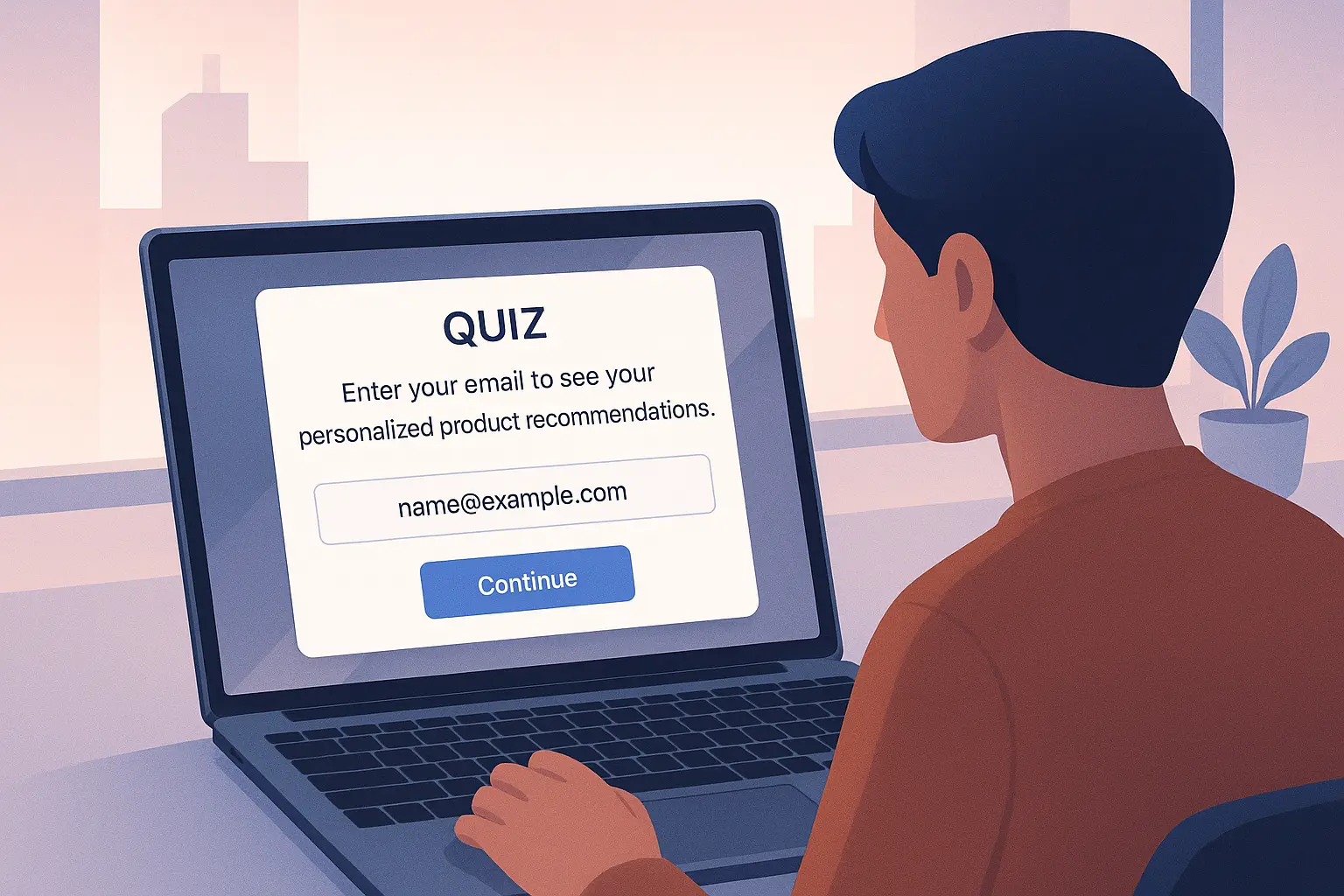Why Email Signups Matter for Shopify Merchants
Email remains one of the most effective channels for e-commerce growth. Returning customers are far more likely to purchase again, and a strong mailing list is a low-cost way to keep driving sales. Yet many Shopify merchants struggle to get shoppers to actually hand over their email addresses.
Pop-ups often feel intrusive, and generic signup boxes are ignored. The average email signup rate for e-commerce websites hovers around 1-3%, meaning 97-99% of visitors leave without joining your list. This represents a massive missed opportunity for future sales and customer relationship building.
Why Quizzes Beat Pop-ups
Product quizzes solve this problem in a unique way. Instead of interrupting shoppers, they guide them. Customers are already engaged by answering a few questions. By the time the email capture field appears, it feels natural. They want to see their personalized results, so they're far more likely to opt in.
This isn't about tricking customers — it's about exchanging value. Shoppers get tailored recommendations, and merchants gain a qualified lead. The psychology is simple: when someone invests time and effort into something (like answering quiz questions), they become more committed to seeing it through.
Traditional pop-up approach: "Subscribe for 10% off!" (Interrupts shopping experience)
Quiz approach: "Find your perfect products → Answer 3 quick questions → Enter email to see results" (Enhances shopping experience)
How AI Quizzes Capture Emails Effectively
The effectiveness of quiz-based email capture comes down to several key psychological and technical factors:
- Strategic placement: The email field appears right before showing product recommendations, when curiosity is at its peak
- Higher intent: Customers who have invested time in the quiz are more motivated to see their results
- Personalization promise: The promise of customized recommendations makes them more willing to subscribe
- Integration ready: Emails can flow directly into marketing tools like Klaviyo, Mailchimp, or Shopify Flow
- Qualified leads: Quiz responses provide valuable data about customer preferences and intent
A Practical Example
A fashion brand selling accessories was struggling with a 1.2% email signup rate from their website pop-up. They decided to try a different approach: a short AI quiz asking about shopper style preferences, occasion needs, and color preferences.
Before displaying recommendations, the quiz invited users to enter their email with the message: "Enter your email to unlock your personalized style matches and get exclusive early access to new collections."
The results were remarkable:
- Email signup rate increased from 1.2% to 8.7% (625% improvement)
- Bounce rate decreased by 23% as customers stayed engaged with the quiz
- Average session duration increased by 2.3 minutes
- Email subscribers from quizzes had a 40% higher lifetime value
- Click-through rates on subsequent email campaigns improved by 35%
The Psychology Behind Quiz Email Capture
Understanding why quizzes work so well for email capture helps you optimize your approach:
- Commitment escalation: Each quiz question increases psychological investment
- Curiosity gap: People want to see their results after investing time in questions
- Value exchange: Clear benefit (personalized recommendations) for clear action (email)
- Social proof: Quizzes feel like expert guidance rather than marketing
- Reduced friction: Email feels like a natural next step, not an interruption
Tips for Shopify Merchants
Ready to implement quiz-based email capture? Here are proven strategies to maximize your success:
- Don't force it: Keep the opt-in optional, but highlight the benefit (exclusive offers, early access, best match products)
- Explain the value clearly: A line like "Enter your email to unlock your tailored product matches" works better than a generic "Subscribe"
- Test positioning: Try showing the opt-in before results, or as part of the recommendations step
- Track performance: Use analytics to compare opt-ins from quizzes vs. other methods
- Segment immediately: Use quiz responses to segment your email list for better targeting
- Follow up quickly: Send personalized recommendations within 24 hours while interest is high
Technical Implementation Best Practices
For optimal results, consider these technical aspects:
- Mobile optimization: Ensure the email capture form works perfectly on mobile devices
- Progressive profiling: Ask for email first, then additional details in follow-up communications
- Integration setup: Connect directly to your ESP (Email Service Provider) for immediate list building
- Compliance ready: Include proper consent language for GDPR and other regulations
- Analytics tracking: Set up conversion tracking to measure quiz-to-email performance
Measuring Success
Track these key metrics to optimize your quiz-based email capture:
- Quiz completion rate: Percentage of people who finish the quiz
- Email capture rate: Percentage of quiz completers who provide email
- Overall conversion: Total visitors to email subscribers
- Email engagement: Open and click rates from quiz-captured emails
- Revenue attribution: Sales generated from quiz-captured email subscribers
Final Thoughts
Email capture doesn't have to feel pushy or intrusive. By embedding AI quizzes into the shopping journey, Shopify merchants can grow their mailing lists naturally while improving the customer experience. The key is providing genuine value in exchange for contact information.
When customers feel like they're getting personalized help rather than being marketed to, they're much more likely to engage. Quiz-based email capture creates a win-win scenario: customers get better product recommendations, and merchants build stronger, more qualified email lists.
Start with a simple 3-4 question quiz focused on helping customers find the right products. Make the email capture feel like a natural next step, and always deliver on the promise of personalized recommendations. With the right approach, you could see your email signup rates increase by 300-500% or more.

